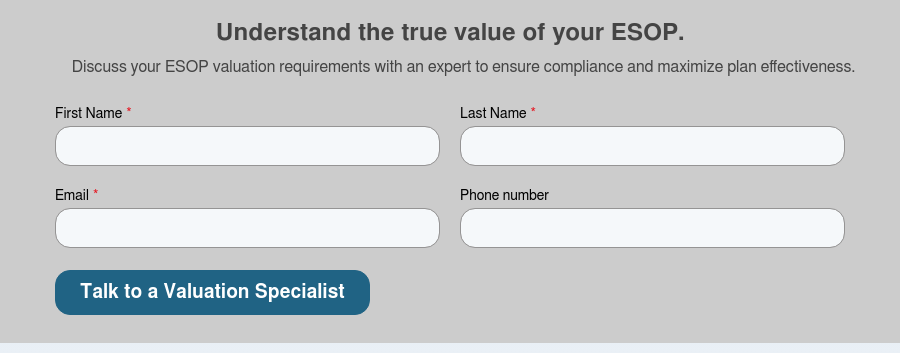Industry Trends
Largest Transactions Closed
- Target
- Buyer
- Value($mm)
Updated 10/30/2025
ESOP companies have a statutory requirement to provide sufficient cash to the ESOP for purposes of repurchasing employee shares. These shares are typically purchased from employees upon their retirement, voluntary or involuntary termination, or death. For most of your ESOP participants, a significant payout can represent years of dedication and hard work and, more important, a significant component of their retirement savings. For your company’s executive team, however, it can create financial challenges.
With an increasing share price comes an increasing repurchase obligation (RPO). Your CFO and other executives want to know, “How does the RPO impact our company’s valuation?” and “How will the RPO impact our future cash flows and ability to grow?” While there is no simple answer to these questions, there are many factors to consider when analyzing the impact. It's crucial to ensure that your valuation firm is equipped to handle these complexities; otherwise, it might be time to consider a new valuation firm.
Your company’s RPO is the liability incurred when ESOP-owned companies grant ESOP participants the right to sell their shares back to the ESOP company. The economic consequence of this right is a “put” given by the ESOP-owned company to the ESOP participants.
The statutory put or RPO liability is slightly misleading, however. Under Generally Accepted Accounting Principles (GAAP), this ongoing liability represents an unfunded obligation not directly reflected on your ESOP company’s balance sheet. In addition, the RPO may have both liability and equity characteristics depending on your ESOP’s method for handling share repurchases.
Several factors drive the RPO – chief among them are (i) the percentage of stock owned by the ESOP participants, (ii) the plan’s distribution rules, and (iii) the methods used to repurchase the shares. Most discussions regarding RPOs, however, involve the methods used; the two primary methods are referred to as “redeeming” and “recycling.” In redeeming, your company repurchases ESOP shares as treasury shares and then retires and removes them as outstanding shares. In recycling, your company can fund the purchase of ESOP shares in several ways, but the ultimate result is that the shares remain outstanding because they’re still owned by the ESOP trust and are reallocated (or “recycled”) to the remaining ESOP participants. These two methods are very different and can have a rather significant impact on the valuation of your company.
In general, both methods can reduce aggregate equity value, but while recycling shares reduces your value per share, redeeming them does not. When you redeem shares, the aggregate equity value declines by the amount of cash used to purchase the shares and the number of shares outstanding decreases. As a result, total equity value declines, but because total shares outstanding decreases, the per-share value remains unchanged.
When you recycle shares, the repurchase is often funded by a contribution from the company. Those shares are then retained in the ESOP and reallocated to the remaining participants. As a result of the shares being recycled, aggregate equity value could decline because of the cost of the contribution, but the number of shares outstanding does not decrease (which could have a dilutive impact on the per-share value). In theory, however, as long as the benefit expense you incur by recycling shares is consistent with normal retirement benefit levels, then recycling should not have a dilutive impact. If the expense exceeds normal retirement benefit levels, the aggregate equity value would decline, with a dilutive impact on the per-share value.
Regardless of RPO mechanics, there is no apparent consensus in the valuation community on whether an RPO should be directly addressed in the valuation presentation. Many believe that not including the RPO leads to an overstatement of your company’s stock price, which, in turn, increases the RPO. So, even with no definitive approach or best practices on how to adjust your valuation for the RPO, many valuation professionals advocate that the repurchase obligation should be a “visible component of the valuation presentation.”
When considering the repurchase obligation in your company’s valuation presentation, several factors should be considered. One such factor is your ability to invest in new opportunities that would generate future growth. While future acquisitions are not typically incorporated into the valuation exercise, your ability to make external investments could impact how your company views organic decisions such as developing new products, replacing fixed assets, or hiring new employees. These decisions could impact your company’s ability to meet future demand and ultimately threaten your competitive advantage.
If a discounted cash flow method for valuation is utilized, you could adjust future cash flows to account for these restrictions on future growth. In other words, instead of investing cash in meaningful, or even necessary purchases, RPOs could limit a company’s ability to grow and would ultimately impair value. Valuation professionals could also account for these restrictions by selecting a higher discount rate that captures the risks of not achieving your company’s projections.
Similarly, if a market approach for valuation is utilized, the selected multiple could be adjusted to account for greater liquidity risks when compared to the peer group.
As another consideration, a higher discount for lack of marketability could be applied to account for risks associated with your company’s ability to repurchase the ESOP shares.
Ultimately, a valuation expert should assess the RPO using his/her professional judgment based on the facts and circumstances as well as the information available. You should also consider third-party actuarial studies of the RPO to help plan for future costs.
Sustainability, a relatively new buzzword in the ESOP community, refers to the ability of an ESOP to continue providing meaningful employee ownership benefits while maintaining financial health and competitiveness. The RPO plays a crucial role in determining the sustainability of an ESOP.
An ESOP sustainability study, as discussed in our article "Employee Ownership, If You Can Keep It: A Guide to ESOP Sustainability," is essential for assessing how long an ESOP can continue to meet its obligations without compromising its financial stability or competitive edge. This study typically involves a detailed analysis of demographic trends within the employee base, financial projections, and the potential impact of RPO on these factors.
The integration of ESOP sustainability studies into regular financial planning processes ensures that the ESOP remains a viable and beneficial component of employee compensation, contributing positively to the company’s culture and financial success. This proactive approach not only addresses immediate financial impacts of the RPO but also aligns with long-term strategic goals, ensuring the ESOP can be sustained as a valuable and integral part of the company’s success.
You should regularly consider your ESOP repurchase obligation strategy and manage it carefully to ensure the RPO is commensurate with ongoing retirements benefits. If properly managed, this obligation should have minimal impact on growth and value, and if total retirement benefits (including the RPO) are consistent with industry standards, there should be no negative impact.
PCE has more than 50 years of combined experience with ESOP transaction and valuation services. We offer a team of dedicated ESOP experts who will guide you through your ESOP company valuation or ESOP transaction processes.
Accurately valuing your ESOP is critical to ensuring regulatory compliance and long-term sustainability. Our seasoned valuation experts provide precise, defensible ESOP valuations, helping your company confidently navigate Department of Labor scrutiny and fiduciary responsibilities.
With our expert valuation services, you'll gain:
Fill out the form below to speak with an ESOP valuation specialist today.

